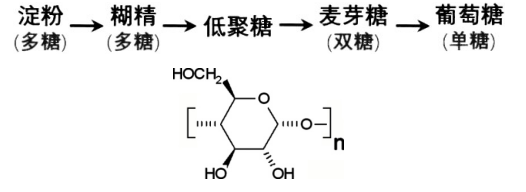Versatile Applications of Dextrin in Various Industries
Time:2024-01-22 Hits:255
Dextrin, a complex mixture of D-glucose polymers linked by α-(1→4) or α-(1→6) glycosidic bonds, emerges as an intermediate during the decomposition and hydrolysis of starch. This versatile substance finds applications across diverse industries, offering a range of benefits.Dextrin possesses a variable degree of polymerization, falling between soluble starch and maltose. When exposed to iodine, it exhibits a distinctive red-brown color, with lower polymerization grades showing no color reaction.

Applications of Dextrin
Dextrin finds widespread utility across various industries such as medicine, food, cosmetics, and environmental protection. Here are specific applications in each domain:
Food Industry: Dextrin serves as a valuable food additive, safeguarding the color, aroma, taste, and nutritional content of food items. It plays a crucial role in extending the shelf life of products like low-fat ice cream and low-calorie drinks.
Pharmaceutical Sector: In pharmaceuticals, dextrin contributes to the formulation of sustained-release drugs and oral preparations. This enhances the bioavailability and stability of drugs, exemplified by dextrin-coated drugs and dextrin microspheres.
Cosmetics Field: Within the cosmetics industry, dextrin is employed to create skincare products and cosmetics with moisturizing, antioxidant, and stabilizing properties. This includes the formulation of moisturizing lotions and antioxidant creams.
Environmental Protection: Dextrin plays a pivotal role in environmental protection, particularly in water and wastewater treatment. It is utilized to eliminate harmful substances and heavy metal ions from water, acting as dextrin adsorbents and forming dextrin membranes.
Dextrin and Its Derivatives
Yellow dextrin is derived by hydrolyzing starch with hydrochloric acid at approximately 180°C, resulting in a yellowish-brown color. It contains minimal starch but includes a small amount of glucose. Applications include its use as a water-soluble glue in rewetting envelope adhesives, a foam flotation additive in the mining industry, a green strength additive in sand casting in the foundry sector, and as a printing thickener in batik resistance etchant dyeing. It also finds application as an adhesive in gouache and leather industries.
Produced by treating corn starch with dilute nitric acid at around 200°C, white dextrin contains starch. It serves various purposes such as enhancing brittleness in food pastes, coatings, and glazes; acting as a textile finishing and coating agent to increase textile weight and stiffness; functioning as a thickening agent in pharmaceuticals and paper coatings; and being employed as a pyrotechnic binder and fuel in fireworks and pyrotechnics, aiding in their solidification into pellets or "stars."
Maltodextrin, a starch derivative, is produced through low-level hydrolysis, purification, and spray drying. Devoid of free starch, it possesses notable characteristics such as high viscosity, robust thickening properties, excellent solubility, instant solubility, effective carrier capabilities, minimal fermentation, low moisture absorption, no distinctive odor, and low sweetness. It is categorized based on its DE value, with MD10 (<11), MD15 (11-16), and MD20 (16-20).
Maltodextrin finds application as a food drying aid, notably in the drying process of fruit juice products. It serves to prevent agglomeration of juice powder products, enhances solubility, and improves product structure. Additionally, it is employed as a food drying agent for encapsulating functional oils, bioactive substances, and flavor substances within microcapsules. Maltodextrin also facilitates protein modification to meet specific food requirements.
Resistant dextrin, a water-soluble dietary fiber derived from edible starch through dextrinization under acidic conditions, remains intact in the digestive tract due to its resistance to human digestive enzymes. Directly entering the intestine without absorption, it functions as a dietary fiber, enhancing intestinal function.
Resistant dextrin is utilized in diabetic foods to slow gastric emptying, reduce food digestion speed, and inhibit blood sugar spikes. It plays a role in promoting beneficial intestinal bacteria proliferation, maintaining the intestinal environment, and reducing the incidence of intestinal diseases. This versatile substance can replace fat in high-calorie beverages, reducing overall product calories. Furthermore, its sugar-like properties allow for integration in dietary fiber-fortified dairy products or milk drinks without altering the original flavor.
Cyclodextrin encompasses a series of cyclic oligosaccharides—α-cyclodextrin, β-cyclodextrin, and γ-cyclodextrin—produced by amylose under the influence of cyclodextrin glycosyltransferase from Bacillus. Characterized by hydrophilicity on the exterior and hydrophobicity on the interior, cyclodextrin readily forms inclusion complexes with hydrophobic guest molecules, enhancing the physical and chemical properties of these molecules, particularly water solubility.
For more product details, please contact us: service@seebio.cn or Phone: +86 21 58183719 or Wechat: +86 158 0195 7578
Dextrin and Derivatives
|
Product
|
Quality Index
|
|
|
Resistant Dextrin
|
Exterior
|
white to light yellow
|
|
Total dietary fiber (g/100g)
|
≥90
|
|
|
Moisture (g/100g)
|
≤6
|
|
|
Ash content (g/100g)
|
≤0.5
|
|
|
pH
|
4~6
|
|
|
Maltodextrin (MD)
|
Exterior
|
white to light yellow
|
|
DE value (on a dry basis)/%)
|
10
|
|
|
Moisture (g/100g)
|
≤6
|
|
|
pH
|
4.5~6.5
|
|
|
Solubility(%)
|
≥98
|
|
|
Sulfated ash (g/100g)
|
≤0.5
|
|
|
Dextrin
|
Exterior
|
White or off-white powder
|
|
acidity
|
This product solution should appear pink
|
|
|
Reducing sugar (leaved cuprous oxide/g)
|
≤0.20
|
|
|
chloride(%)
|
≤0.2
|
|
|
Sulfate(%)
|
≤0.1
|
|
|
Nitrate(%)
|
≤0.2
|
|
|
Loss on drying(%)
|
≤10.0
|
|
|
Residue on ignition(%)
|
≤0.5
|
|
|
Heavy metals, ppm (mg/kg)
|
≤20
|
|
|
iron salt(%)
|
≤0.005
|
|
|
Yellow dextrin
|
Exterior
|
Yellow or yellow-brown powder
|
|
Moisture (g/100g)
|
≤6
|
|
|
pH
|
4~6
|
|
|
Solubility(%)
|
≥98
|
|
